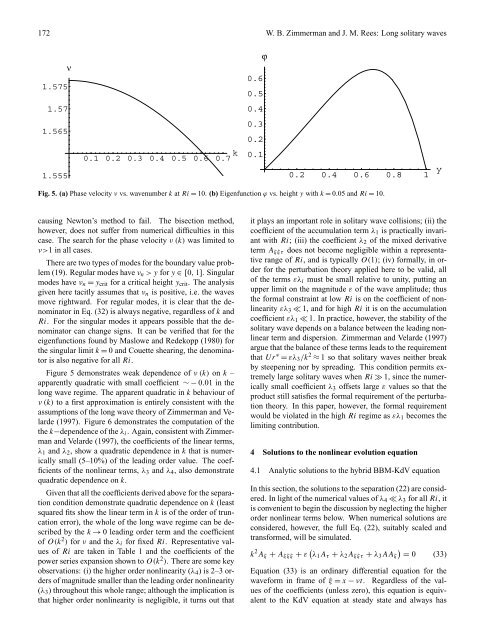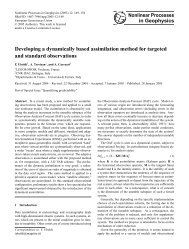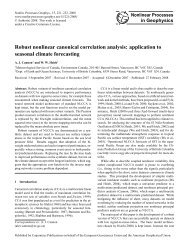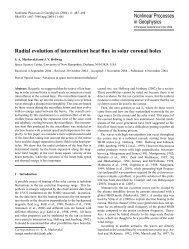Long solitary internal waves in stable stratifications
Long solitary internal waves in stable stratifications
Long solitary internal waves in stable stratifications
You also want an ePaper? Increase the reach of your titles
YUMPU automatically turns print PDFs into web optimized ePapers that Google loves.
172 W. B. Zimmerman and J. M. Rees: <strong>Long</strong> <strong>solitary</strong> <strong>waves</strong><br />
ν<br />
1.575<br />
ϕ<br />
0.6<br />
0.5<br />
1.57<br />
0.4<br />
1.565<br />
1.555<br />
0.1 0.2 0.3 0.4 0.5 0.6 0.7 k<br />
0.3<br />
0.2<br />
0.1<br />
0.2 0.4 0.6 0.8 1 y<br />
Fig. 5. (a) Phase velocity ν vs. wavenumber k at Ri = 10. (b) Eigenfunction ϕ vs. height y with k = 0.05 and Ri = 10.<br />
caus<strong>in</strong>g Newton’s method to fail. The bisection method,<br />
however, does not suffer from numerical difficulties <strong>in</strong> this<br />
case. The search for the phase velocity ν (k) was limited to<br />
ν>1 <strong>in</strong> all cases.<br />
There are two types of modes for the boundary value problem<br />
(19). Regular modes have ν n > y for y ∈ [0, 1]. S<strong>in</strong>gular<br />
modes have ν n = y crit for a critical height y crit . The analysis<br />
given here tacitly assumes that ν n is positive, i.e. the <strong>waves</strong><br />
move rightward. For regular modes, it is clear that the denom<strong>in</strong>ator<br />
<strong>in</strong> Eq. (32) is always negative, regardless of k and<br />
Ri. For the s<strong>in</strong>gular modes it appears possible that the denom<strong>in</strong>ator<br />
can change signs. It can be verified that for the<br />
eigenfunctions found by Maslowe and Redekopp (1980) for<br />
the s<strong>in</strong>gular limit k = 0 and Couette shear<strong>in</strong>g, the denom<strong>in</strong>ator<br />
is also negative for all Ri.<br />
Figure 5 demonstrates weak dependence of ν (k) on k –<br />
apparently quadratic with small coefficient ∼ − 0.01 <strong>in</strong> the<br />
long wave regime. The apparent quadratic <strong>in</strong> k behaviour of<br />
ν (k) to a first approximation is entirely consistent with the<br />
assumptions of the long wave theory of Zimmerman and Velarde<br />
(1997). Figure 6 demonstrates the computation of the<br />
the k−dependence of the λ i . Aga<strong>in</strong>, consistent with Zimmerman<br />
and Velarde (1997), the coefficients of the l<strong>in</strong>ear terms,<br />
λ 1 and λ 2 , show a quadratic dependence <strong>in</strong> k that is numerically<br />
small (5–10%) of the lead<strong>in</strong>g order value. The coefficients<br />
of the nonl<strong>in</strong>ear terms, λ 3 and λ 4 , also demonstrate<br />
quadratic dependence on k.<br />
Given that all the coefficients derived above for the separation<br />
condition demonstrate quadratic dependence on k (least<br />
squared fits show the l<strong>in</strong>ear term <strong>in</strong> k is of the order of truncation<br />
error), the whole of the long wave regime can be described<br />
by the k → 0 lead<strong>in</strong>g order term and the coefficient<br />
of O(k 2 ) for ν and the λ i for fixed Ri. Representative values<br />
of Ri are taken <strong>in</strong> Table 1 and the coefficients of the<br />
power series expansion shown to O(k 2 ). There are some key<br />
observations: (i) the higher order nonl<strong>in</strong>earity (λ 4 ) is 2–3 orders<br />
of magnitude smaller than the lead<strong>in</strong>g order nonl<strong>in</strong>earity<br />
(λ 3 ) throughout this whole range; although the implication is<br />
that higher order nonl<strong>in</strong>earity is negligible, it turns out that<br />
it plays an important role <strong>in</strong> <strong>solitary</strong> wave collisions; (ii) the<br />
coefficient of the accumulation term λ 1 is practically <strong>in</strong>variant<br />
with Ri; (iii) the coefficient λ 2 of the mixed derivative<br />
term A ξξτ does not become negligible with<strong>in</strong> a representative<br />
range of Ri, and is typically O(1); (iv) formally, <strong>in</strong> order<br />
for the perturbation theory applied here to be valid, all<br />
of the terms ελ i must be small relative to unity, putt<strong>in</strong>g an<br />
upper limit on the magnitude ε of the wave amplitude; thus<br />
the formal constra<strong>in</strong>t at low Ri is on the coefficient of nonl<strong>in</strong>earity<br />
ελ 3 ≪ 1, and for high Ri it is on the accumulation<br />
coefficient ελ 1 ≪ 1. In practice, however, the stability of the<br />
<strong>solitary</strong> wave depends on a balance between the lead<strong>in</strong>g nonl<strong>in</strong>ear<br />
term and dispersion. Zimmerman and Velarde (1997)<br />
argue that the balance of these terms leads to the requirement<br />
that Ur ∗ = ελ 3 /k 2 ≈ 1 so that <strong>solitary</strong> <strong>waves</strong> neither break<br />
by steepen<strong>in</strong>g nor by spread<strong>in</strong>g. This condition permits extremely<br />
large <strong>solitary</strong> <strong>waves</strong> when Ri ≫ 1, s<strong>in</strong>ce the numerically<br />
small coefficient λ 3 offsets large ε values so that the<br />
product still satisfies the formal requirement of the perturbation<br />
theory. In this paper, however, the formal requirement<br />
would be violated <strong>in</strong> the high Ri regime as ελ 1 becomes the<br />
limit<strong>in</strong>g contribution.<br />
4 Solutions to the nonl<strong>in</strong>ear evolution equation<br />
4.1 Analytic solutions to the hybrid BBM-KdV equation<br />
In this section, the solutions to the separation (22) are considered.<br />
In light of the numerical values of λ 4 ≪ λ 3 for all Ri, it<br />
is convenient to beg<strong>in</strong> the discussion by neglect<strong>in</strong>g the higher<br />
order nonl<strong>in</strong>ear terms below. When numerical solutions are<br />
considered, however, the full Eq. (22), suitably scaled and<br />
transformed, will be simulated.<br />
k 2 A ξ + A ξξξ + ε ( λ 1 A τ + λ 2 A ξξτ + λ 3 AA ξ<br />
)<br />
= 0 (33)<br />
Equation (33) is an ord<strong>in</strong>ary differential equation for the<br />
waveform <strong>in</strong> frame of ξ = x − νt. Regardless of the values<br />
of the coefficients (unless zero), this equation is equivalent<br />
to the KdV equation at steady state and always has






